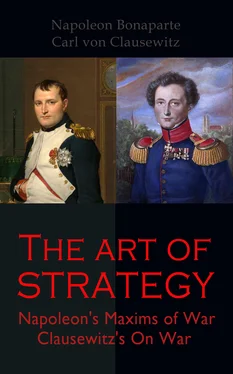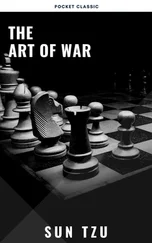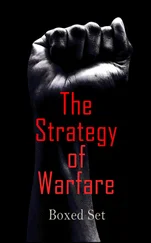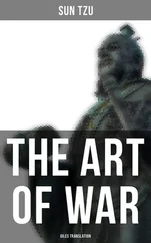It is to be remembered, too, that by profiting judiciously by the lines of contravallation, a portion of the besieging army will always be available in giving battle to the approaching enemy.
Upon the same general principle, when a place is to be besieged in presence of an enemy’s army, it is necessary to cover the siege by lines of circumvallation .
If the besieging force is of numerical strength enough (after leaving a corps before the place four times the amount of the garrison) to cope with the relieving army, it may remove more than one day’s march from the place; but if it be inferior in numbers after providing for the siege, as above stated, it should remain only a short day’s march from the spot, in order to fall back upon its lines, if necessary, or receive succor in case of attack.
If the investing corps and army of observation are only equal when united to the relieving force, the besieging army should remain entire within, or near its lines, and push the works and the siege with the greatest activity.
“When we undertake a siege,” says Montécuculli, “we should not seek to place ourselves opposite the weakest part of the fortress, but at the point most favorable for establishing a camp and executing the designs we have in view.”
This maxim was well understood by the Duke of Berwick. Sent to form the siege of Nice in 1706, he determined to attack on the side of Montalban, contrary to the advice of Vauban, and even to the orders of the king. Having a very small army at his disposal, he began by securing his camp. This he did by constructing redoubts upon the heights that shut in the space between the Var and the Paillon, two rivers which supported his flanks. By this means, he protected himself against a surprise; for the Duke of Savoy, having the power of debouching suddenly by the Col de Tende, it was necessary that the marshal should be enabled to assemble his forces, so as to move rapidly upon his adversary, and fight him before he got into position; otherwise his inferiority in numbers would have obliged him to raise the siege.
When Marshal Saxe was besieging Brussels, with only twenty-eight thousand men, opposed to a garrison of twelve thousand, he received intelligence that the Prince of Waldeck was assembling his forces to raise the siege. Not being strong enough to form an army of observation, the marshal reconnoitred a field of battle on the little river Voluve, and made all the necessary dispositions for moving rapidly to the spot, in case of the approach of the enemy. By this means he was prepared to receive his adversary without discontinuing the operations of the siege.
Table of Contents
Feuquière says that “we should never wait for the enemy in the lines of circumvallation, but we should go out and attack him.” He is in error. There is no authority in war without exception; and it would be dangerous to proscribe the principle of awaiting the enemy within the lines of circumvallation.
During the siege of Mons, in 1691, the Prince of Orange assembled his army, and advanced as far as Notre Dame de Halle, making a demonstration to succor the place. Louis XIV, who commanded the siege in person, called a council of war to deliberate on what was to be done in case the Prince of Orange approached. The opinion of Marshal Luxembourg was to remain within the lines of circumvallation, and that opinion prevailed.
The marshal laid it down as a principle that, when the besieging army is not strong enough to defend the whole extent of circumvallation, it should quit the lines and advance to meet the enemy; but when it is strong enough to encamp in two lines around a place, that it is better to profit by a good entrenchment—more especially as by this means the siege is not interrupted.
In 1658, Marshal Turenne was besieging Dunkirk. He had already opened the trenches, when the Spanish army, under the orders of the Prince Don Juan, Condé, and D’Hocquincourt, appeared in sight, and took post upon the Downs, at a distance of a league from his lines. Turenne had the superiority in numbers, and he determined to quit his entrenchments. He had other advantages also. The enemy was without artillery, and their superiority in cavalry was rendered useless by the unfavorable nature of the ground. It was, therefore, of great importance to beat the Spanish army before it had time to entrench itself and bring up its artillery. The victory gained by the French on this occasion justified all the combinations of Marshal Turenne.
When Marshal Berwick was laying siege to Philipsburg, in 1733, he had reason to apprehend that the Prince of Savoy would attack him with all the forces of the empire before its termination. The marshal, therefore, after having made his disposition of the troops intended for the siege, formed, with the rest of his army, a corps of observation to make head against Prince Eugene, in case the latter should choose to attack him in his lines, or attempt a diversion on the Moselle or Upper Rhine. Prince Eugene, having arrived in front of the besieging army, some general officers were of opinion that it was better not to await the enemy in the lines, but to move forward and attack him. But Marshal Berwick, who agreed with the Duke of Luxembourg, that an army which can occupy, completely, good entrenchments is not liable to be forced, persisted in remaining within his works. The result proved that this was also the opinion of Prince Eugene, for he did not dare to attack the entrenchments, which he would not have failed to do if he had any hopes of success.
Table of Contents
Those who proscribe lines of circumvallation, and all the assistance which the science of the engineer can afford, deprive themselves gratuitously of an auxiliary which is never injurious, almost always useful, and often indispensable. It must be admitted, at the same time, that the principles of field-fortification require improvement. This important branch of the art of war has made no progress since the time of the ancients. It is even inferior at this day to what it was two thousand years ago. Engineer officers should be encouraged in bringing this branch of their art to perfection, and in placing it upon a level with the rest.
“If we are inferior in numbers,” says Marshal Saxe, “entrenchments are of no use, for the enemy will bring all his forces to bear upon particular points. If we are of equal strength they are unnecessary also. If we are superior, we do not want them. Then why give ourselves the trouble to entrench?” Notwithstanding this opinion of the inutility of entrenchments, Marshal Saxe often had recourse to them.
In 1797, Generals Provéra and Hohenzollern having presented themselves before Mantua (where Marshal Wurmser was shut up), for the purpose of raising the siege, they were stopped by the lines of contravallation of St. George. This slight obstacle sufficed to afford Napoleon time to arrive from Rivoli and defeat their enterprise. It was in consequence of neglecting to entrench themselves that the French had been obliged to raise the siege in the preceding campaign.
Table of Contents
If circumstances prevent a sufficient garrison being left to defend a fortified town, which contains an hospital and magazines, at least every means should be employed to secure the citadel against a coup de main .
A few battalions dispersed about a town, inspire no terror; but shut up in the more narrow outline of a citadel, they assume an imposing attitude. For this reason it appears to me that such a precaution is always necessary, not only in fortresses, but wherever there are hospitals or depôts of any kind. Where there is no citadel, some quarter of the town should be fixed upon most favorable for defence, and entrenched in such a manner as to oppose the greatest resistance possible.
Читать дальше












